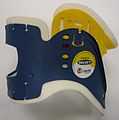Cervical collar

A cervical collar (also neck brace) is an orthopedic medical device used to support a patient's neck and head. It is also used by emergency personnel for those who have had traumatic head or neck injuries,[1] and can be used to treat chronic medical conditions.
Whenever patients have a traumatic head or neck injury, they may have a cervical fracture. This makes them at high risk for spinal cord injury, which could be exacerbated by movement of the patient and could lead to paralysis or death. A common scenario for this injury would be a patient suspected of having whiplash because of a car accident.[2] In order to prevent further injury, such patients may have a collar placed by medical professionals until X-rays can be taken to determine if a cervical spine fracture exists.[3] The cervical collar only stabilizes the top seven vertebrae, C1 through C7. (Other immobilizing devices such as a Kendrick Extrication Device or a backboard can be used to stabilize the remainder of the spinal column.[1])
Cervical collars are also used therapeutically to help realign the spinal cord and relieve pain,[4] although they are usually not worn for long periods of time.[5] Another use of the cervical collar is for strains, sprains or whiplash.[2][3] If pain is persistent, the collar might be required to remain attached to help in the healing process.[3][4] A patient may also need a cervical collar, or may require a halo fixation device to support the neck during recovery after surgery such as cervical spinal fusion.[6]
Types of cervical collars
A soft collar is fairly flexible and is the least limiting but can carry a high risk of further breakage, especially in patients with osteoporosis. It can be used for minor injuries or after healing has allowed the neck to become more stable.
A range of manufactured rigid collars are also used, usually comprising (a) a firm plastic bi-valved shell secured with Velcro straps and (b) removable padded liners. The most frequently prescribed are the Aspen, Malibu, Miami J, and Philadelphia collars. All these can be used with additional chest and head extension pieces to increase stability.
Cervical collars are incorporated into rigid braces that constrain the head and chest together.[7] Examples include the Sterno-Occipital Mandibular Immobilization Device (SOMI), Lerman Minerva and Yale types. Special patients, such as very young children or non-cooperative adults, are sometimes still immobilized in medical plaster of paris casts, such as the Minerva cast.
Cervical collar in sport
In high-risk motorsports such as Motocross, go-kart racing and speed-boat racing, racers often wear a protective collar to avoid whiplash and other neck injuries.
Designs range from simple foam collars to complex composite devices.[8]
-

A Motocross rider wearing a sports neck brace
-
Side view of a cervical collar
-
Front view of a cervical collar
See also
References
- ↑ 1.0 1.1 Mistovich, Joseph J.; Brent Q. Hafen, Keith J Karren (2000). Brady Prehospital Emergency Care (6 ed.). Upper Saddle River, NJ: Prentice-Hall. p. 662. ISBN 0-8359-6064-1.
- ↑ 2.0 2.1 "Whiplash". WebMD. Retrieved 2008-03-07.
- ↑ 3.0 3.1 3.2 "Neck Strains". WebMD. Retrieved 2008-03-07.
- ↑ 4.0 4.1 "Cervical Disc Disease Treatment: Physical Therapy and Other Options". WebMD. Retrieved 2008-03-07.
- ↑ "Office Ergonomics - Other Treatment for Injuries Related to the Workstation". WebMD. Retrieved 2008-03-07.
- ↑ "Cervical spinal fusion". WebMD. Retrieved 2008-03-07.
- ↑ Shantanu S Kulkarni, DO and Robert H Meier III, "Spinal Orthotics", Medscape Reference.
- ↑ "Valhalla Adult 360 Plus Device Karting Neck Brace". Retrieved 2010-08-16.

